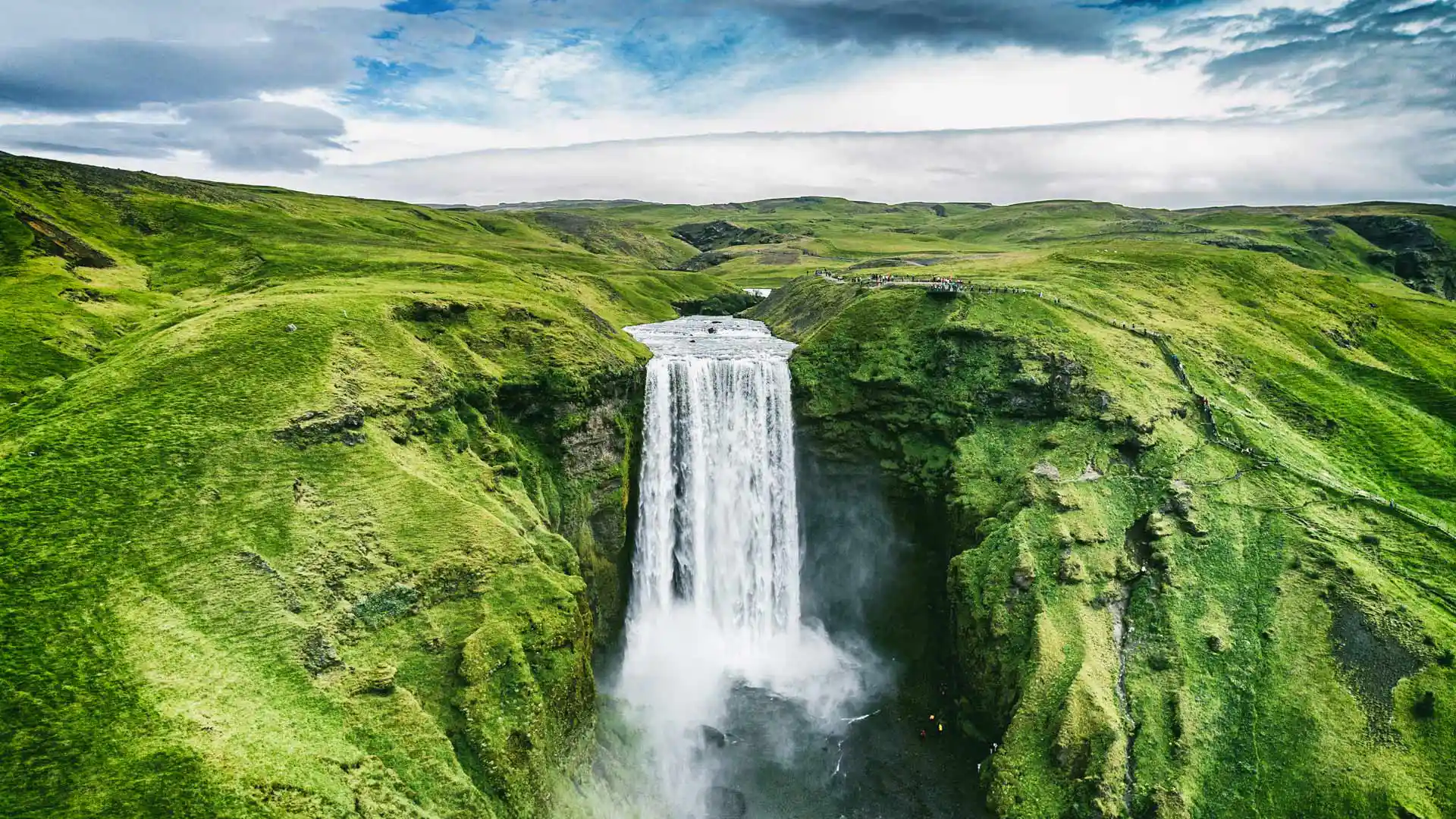塞里雅兰瀑布日落美景,冰岛 Seljalandsfoss waterfall at sunset, Iceland (© Tom Mackie/AWL/plainpicture)
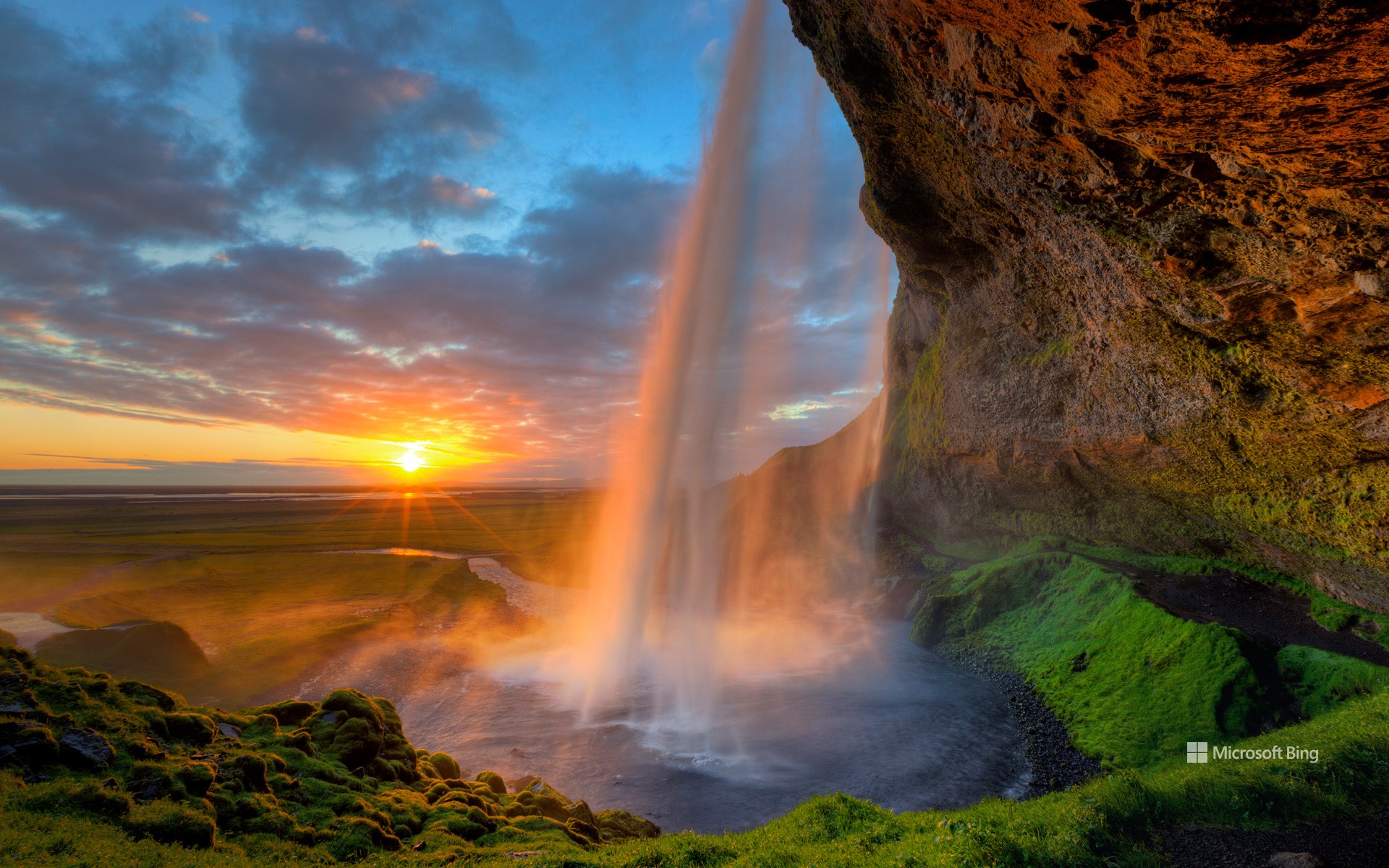
塞里雅兰瀑布日落美景,冰岛 Seljalandsfoss waterfall at sunset, Iceland (© Tom Mackie/AWL/plainpicture)
一切准备就绪,等待日落 Everything is ready, waiting for sunset
塞里雅兰瀑布,冰岛
这座197英尺高的瀑布从曾经标志着冰岛海岸线的悬崖峭壁倾泻而下。奔腾的瀑布是塞里雅兰河 (Seljalandsa River) 的一部分,发源于火山冰川埃亚菲亚德拉冰盖 (Eyjafjallajökull)。这座冰盖下的火山上次喷发是在2010年,对当地居民和空中交通造成了影响。游客可以走到瀑布后面的一个小洞穴,那里拥有独特的视角,也是摄影师的最爱。夜晚,泛光灯照亮了瀑布,营造出一幅梦幻般的景象。如果您计划在夏至期间度假,塞里雅兰瀑布 (Seljalandsfoss) 值得列入您的旅行清单。无论您是自然爱好者还是摄影爱好者,这次体验都将为您留下难忘的回忆。
卡尔夫沙马尔斯维克湾玄武岩柱,斯卡吉半岛,冰岛 Basalt columns at Kálfshamarsvík, Skagi Peninsula, Iceland (© Arterra Picture Library/Alamy Stock Photo)
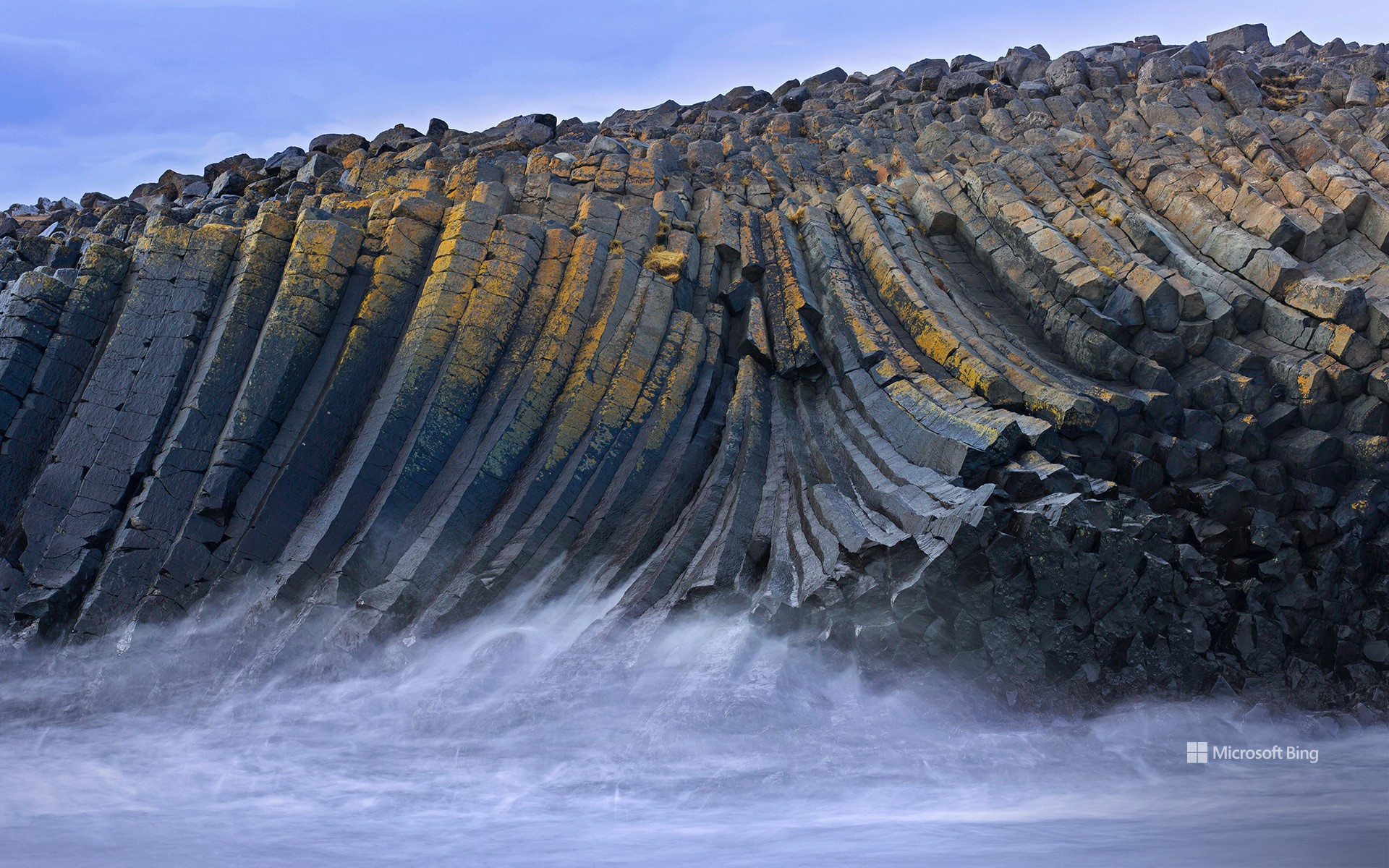
卡尔夫沙马尔斯维克湾玄武岩柱,斯卡吉半岛,冰岛 Basalt columns at Kálfshamarsvík, Skagi Peninsula, Iceland (© Arterra Picture Library/Alamy Stock Photo)
层层叠叠的岩石 Rockin' those layers
国际岩石日
你觉得岩石只是……岩石吗?这些天然的矿物组合不仅仅只是静静地待在原地,它们是地球地壳的基本组成单位,从石器时代的工具到为现代文明提供动力的矿物,岩石在人类发展史中发挥了重要作用。国际岩石日的设立,正是为了庆祝岩石在自然界及人类社会中的深远影响,激发公众对地质科学的兴趣,并鼓励人们欣赏岩石所展现的自然之美与多样性。
若想直观感受地质作用的壮观场景,冰岛无疑是理想之地。今日图片所示地点为冰岛北部偏远的斯卡格半岛,一处宁静的海湾:卡尔夫沙马尔斯维克。与冰岛著名的黑沙滩不同,这里布满了巨大的光滑鹅卵石,其周边高耸的海崖则清晰记录了该地区火山活动的历史。在这些海崖中,稀有的六边形玄武岩柱展现了火山地质作用的典范。这些看似人工雕琢的对称结构,实则为自然形成的地质奇观。这些玄武岩柱的形成可追溯至约两百万年前,当时大量玄武岩熔岩缓慢冷却,体积收缩并产生裂缝,裂缝逐步演化为规则的几何形状,最终形成近乎完美的六边形岩柱。尽管冰岛火山景观众多,但如此规模与规则性兼具的地貌极为罕见,使这片静谧的海湾显得尤为独特与珍贵。
Iceland for International Rock Day
Do you think rocks are just … well, rocks? These natural mineral combinations have done more than just sit around—they've built the Earth's crust and helped humans shape history. From Stone Age tools to the minerals powering modern civilization, rocks have been essential throughout our journey. International Rock Day celebrates this enduring impact, inviting us to explore the science of rocks, admire their natural beauty, and recognize the rich variety they add to our world.
If you're wondering where to see geology in action, Iceland is a great place to explore. Today's image takes us to Kálfshamarsvík—a secluded cove on the country's remote Skagi Peninsula. Unlike Iceland's famous black sand beaches, this cove's shore is strewn with large, smooth pebbles, while its fiery volcanic past still reveals itself in the towering cliffs. Here, evidence of volcanic activity is on full display in the form of rare hexagonal basalt columns. These sea cliffs are shaped into natural sculptures so symmetrical that they look almost human-made. These striking formations were created around 2 million years ago, when thick basalt lava cooled slowly, contracting and cracking into geometric shapes that form near-perfect hexagons. Though Iceland is full of volcanic marvels, formations like these are rare, making this quiet cove truly remarkable.
冰岛的史托克间歇泉 Strokkur geyser in Iceland (© John and Tina Reid/Getty Images)
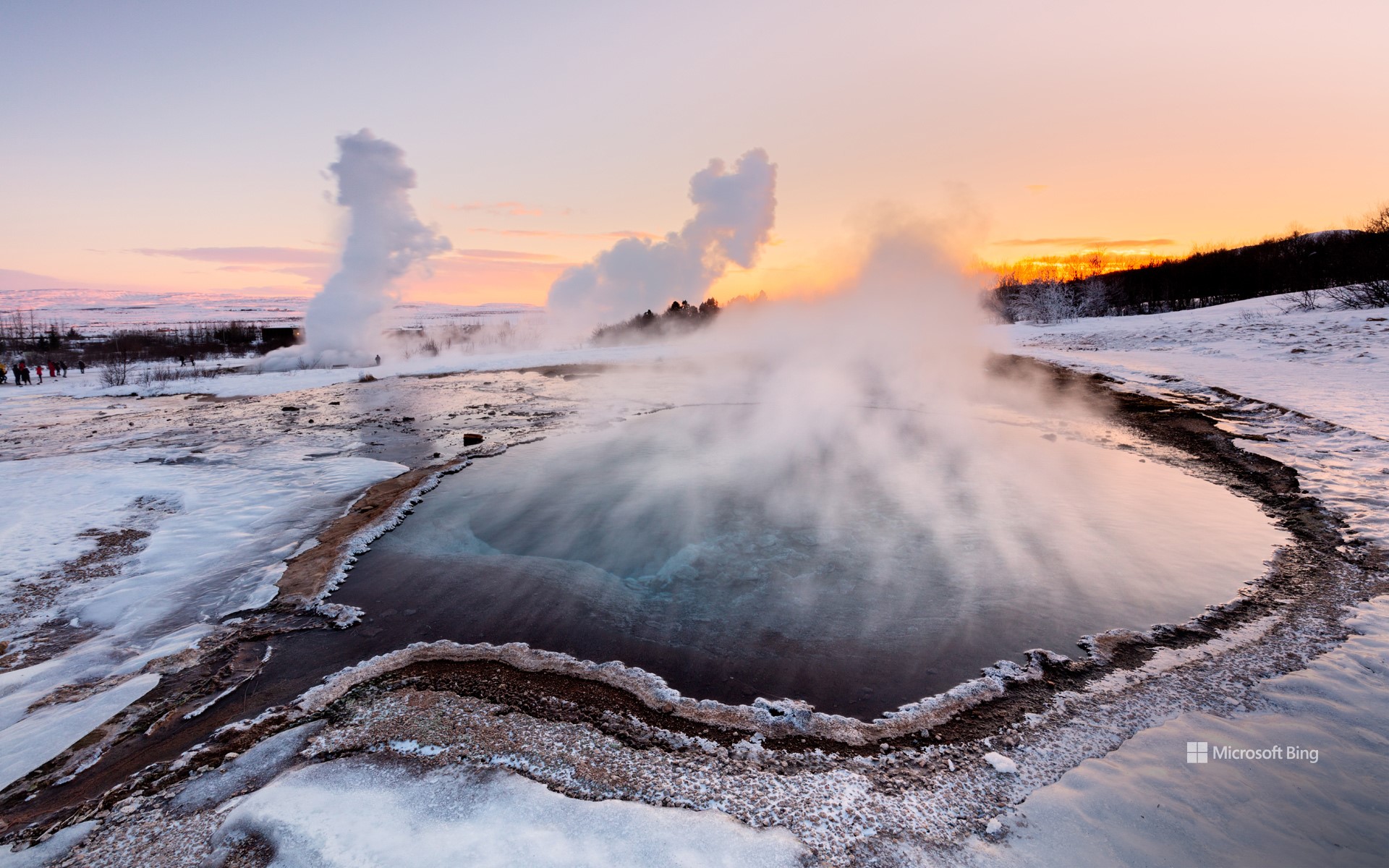
冰岛的史托克间歇泉 Strokkur geyser in Iceland (© John and Tina Reid/Getty Images)
力量沸腾 Bubbling with power
臭食节:冰岛的仲冬节
还有什么比一场充满乐趣与野性的盛宴更能温暖寒冬呢?臭食节作为冰岛的冬至节,邀请人们深入体验传统文化。这一庆祝活动围绕生存、文化和社区展开,可追溯至维京时代,当时冰岛人用它祭祀雷神托尔。如今,人们聚在一起,通过享用发酵鲨鱼肉、熏羊肉、黑麦面包及‘黑死神’布伦尼温烈酒等当地美食来庆祝这一节日。
图片中的斯特罗克尔间歇泉则以另一种方式温暖着冬天。它位于赫维塔河旁的地热区,每隔 6 至 10 分钟喷发一次,热水可喷射至49到66英尺的高空,自1963年以来持续活跃。其喷发原理是地壳下的岩浆加热地下水,压力逐渐增大,最终将热水爆发式喷射到地表。无论是索拉布洛特的庆典,还是斯特罗克尔间歇泉的喷发,它们都展现了冰岛顽强不屈的精神:一种体现在人民身上,另一种根植于土地之中。
Thorrablot: The Icelandic midwinter festival
What could be better than warming up winter with a feast that's a little wild and a lot of fun? Thorrablot, Iceland's midwinter festival, invites you to dive headfirst into tradition. This celebration of survival, culture, and community, which dates to the Viking Age, was once a way for Icelanders to honor Thor, the Norse god of thunder. Today, people celebrate by gathering to feast on an array of local delicacies, including fermented shark, smoked lamb, rye bread, and shots of Brennivín—often called 'black death' schnapps.
Strokkur geyser—featured in the image—warms up winter in a completely different way. Located in the geothermal area beside the Hvítá River, this geyser erupts every 6 to 10 minutes, shooting hot water 49 to 66 feet into the air. It has been consistently active since 1963. There is science behind its eruption—magma beneath the Earth's crust heats groundwater until the pressure builds up, forcing the water explosively to the surface. Both Thorrablot and Strokkur celebrate Iceland's resilience—one through its people and the other through its land.
冰岛冰川河流鸟瞰图 Aerial view of glacial rivers in Iceland (© rybarmarekk/Shutterstock)
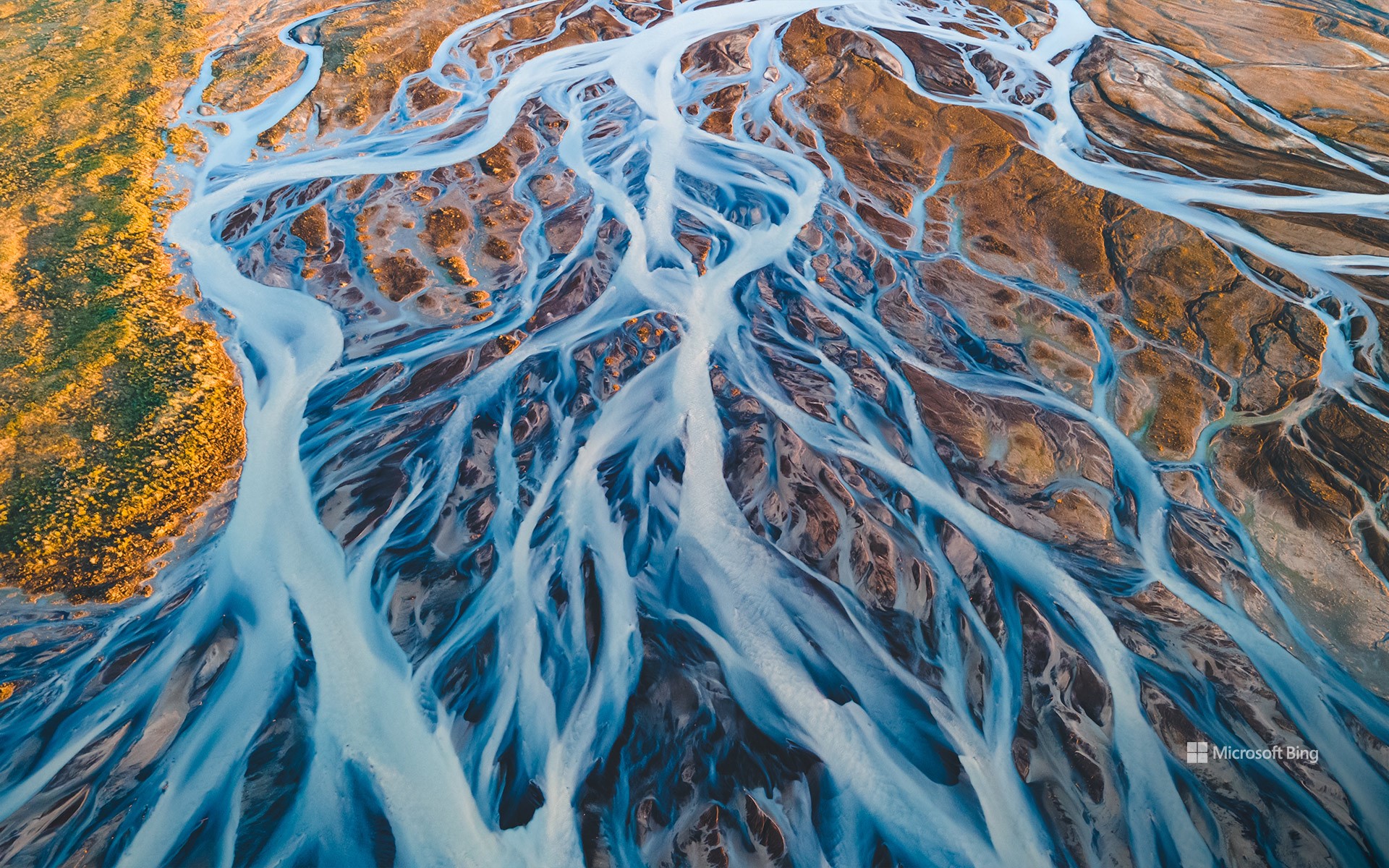
冰岛冰川河流鸟瞰图 Aerial view of glacial rivers in Iceland (© rybarmarekk/Shutterstock)
来自冰与火之国 From the land of fire and ice
冰川河流,冰岛
“冰与火之国”冰岛的冰川河流在数千年的时间里塑造了冰岛的地貌。今天图片中的河流就是由瓦特纳、朗格和霍夫斯等巨大冰川的融水形成的。瓦特纳冰川是冰岛第一大冰川,覆盖面积超3000平方英里,约占冰岛国土面积10%。冰川融化后,冰川水携带着细小的沉积物,形成了乳白色的辫状河流系统,与火山地形的泥土色调形成鲜明对比。每年春夏季节,河流都会因季节性融水而激增,不断塑造和重塑这片土地。从空中俯瞰,可以看到它们错综复杂的图案,就像一幅幅复杂的艺术品,在地形上交织着向北大西洋延伸。冰岛的水不仅仅是一道美丽的风景,它在可再生能源方面也发挥着重要作用。水流为水电站提供动力,巩固了冰岛作为可持续能源领导者的地位。
Glacial rivers in Iceland
Iceland's glacial rivers have shaped the landscape here in the land of fire and ice over thousands of years. The rivers seen in today's image are formed from the meltwater of vast glaciers like Vatnajökull, Langjökull, and Hofsjökull. Vatnajökull, the largest ice cap in Iceland, covers over 3,000 square miles—approximately 10% of the country's landmass. As the glaciers melt, the water carries fine sediments, creating a braided river system with a milky appearance that contrasts with the earthy tones of the volcanic terrain. Every spring and summer, the rivers swell with seasonal meltwater, continually shaping and reshaping the land. Aerial views reveal their intricate patterns, interwoven across the terrain toward the North Atlantic Ocean. The water also powers hydroelectric power stations, reinforcing Iceland's status as a leader in sustainable energy.
斯卡夫塔山的瀑布,瓦特纳冰川国家公园,冰岛 Waterfall in Skaftafell, Vatnajökull National Park, Iceland (© Nopasorn Kowathanakul/Getty Images)
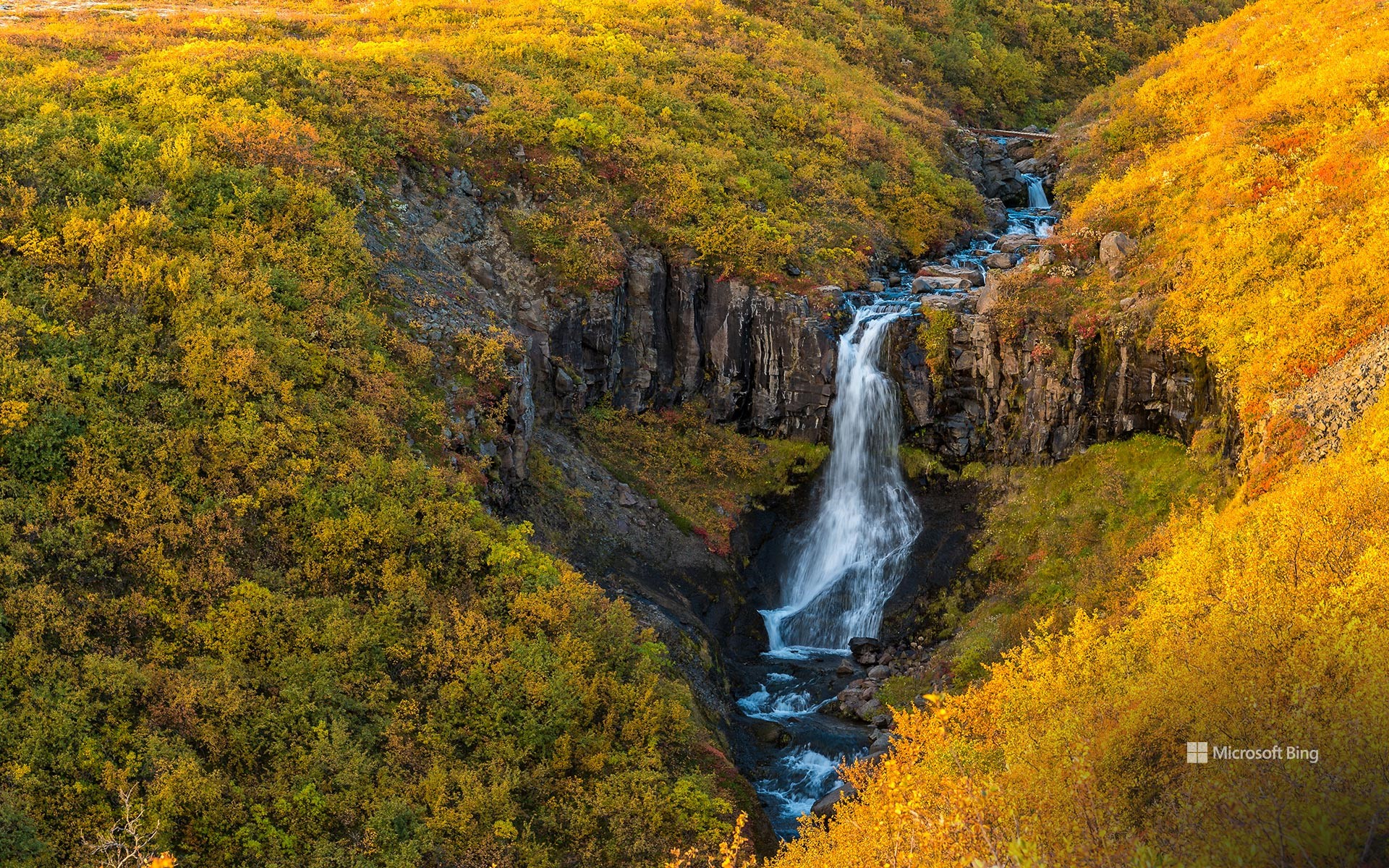
斯卡夫塔山的瀑布,瓦特纳冰川国家公园,冰岛 Waterfall in Skaftafell, Vatnajökull National Park, Iceland (© Nopasorn Kowathanakul/Getty Images)
你会相信这种观点吗? Falling for this view?
斯卡夫塔山,瓦特纳冰川国家公园,冰岛
在冰岛的斯卡夫塔山,秋天不仅仅是一个季节,更是一种体验。从冰川到瀑布,再到北极光,瓦特纳冰川国家公园中的这片区域展示了大自然的原始之美。斯卡夫山曾经是一个繁荣的农场,现在是一个保护区,它是几千年来火山火焰和冰川水激烈交织形成的。作为欧洲第二大冰盖瓦特纳冰川的一个分支,斯卡夫塔山冰川像一条冰冻的河流一样延伸开来,吸引着游客在导游的带领下徒步旅行。公园内的斯瓦蒂瀑布的水源则来自冰川融水。瀑布周围环绕着深色的熔岩柱,从远处看就像一颗心脏,冰岛国家大剧院和雷克雅未克的哈尔格林姆斯教堂的设计灵感就来源于此。斯卡夫塔山的徒步路径既有简单的步行道,又有具有挑战性的攀登路线,每个人都能在这里找到适合自己的路。虽然这个季节的日照时间可能较短,但也有好的地方。当夜幕降临时,极光经常出现,将天空变成绿色和粉色的混合漩涡。
Skaftafell, Vatnajökull National Park, Iceland
In Iceland's Skaftafell, fall isn't just a season—it's an experience. From glaciers to waterfalls, like the one featured here today, to northern lights, this area in Vatnajökull National Park is a showcase of nature's raw beauty. Skaftafell's dramatic landscape was formed over thousands of years by the fierce interplay of volcanic fire and glacial water. Here, the glacier Skaftafellsjökull, a branch of Iceland's largest ice cap, Vatnajökull, stretches out like a frozen river, inviting visitors for guided hikes. Then there's Svartifoss, another waterfall in the park, fed by glacial meltwater. Surrounded by dark lava columns resembling a heart from afar, this waterfall inspired the design of Iceland's National Theatre and the Hallgrímskirkja church in Reykjavík.
Skaftafell's hiking trails range from easy walks to challenging climbs, so there's something for everyone. While the daylight hours may be shorter in this season, there's a bright side—literally. As night falls, the auroras often appear, turning the sky into a swirling mix of green and pink.
日出时的羽扇豆田和教堂,斯奈山半岛,冰岛 Lupine fields and church at sunrise, Snæfellsnes Peninsula, Iceland (© Matteo Colombo/Getty Images)
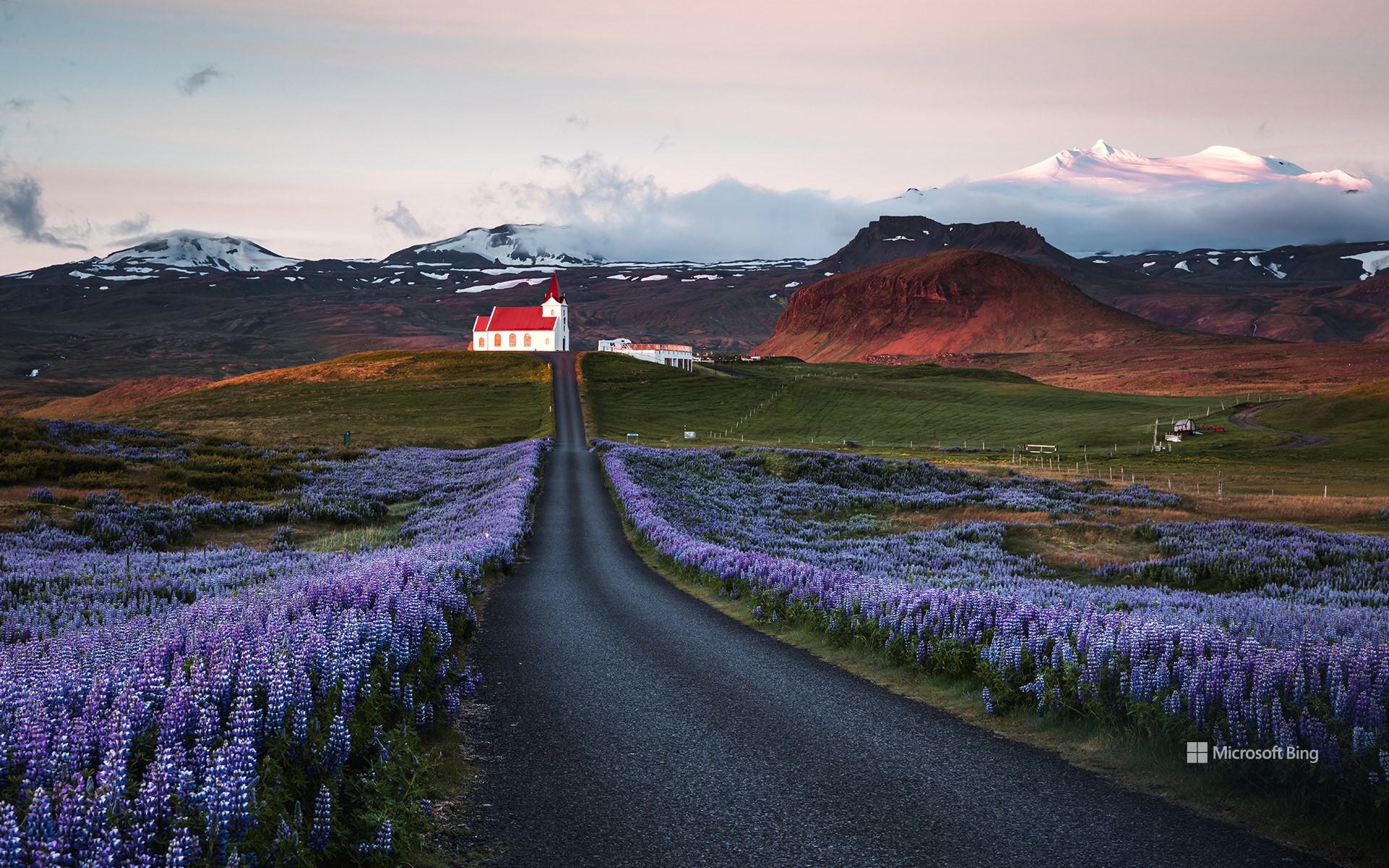
日出时的羽扇豆田和教堂,斯奈山半岛,冰岛 Lupine fields and church at sunrise, Snæfellsnes Peninsula, Iceland (© Matteo Colombo/Getty Images)
羽扇豆田和教堂,斯奈山半岛,冰岛
随着冰岛春夏交替,崎岖的地貌呈现出五彩缤纷的景象。由于羽扇豆的根部具有土壤粘结性,冰岛在20世纪40年代引进了羽扇豆,用于控制水土流失。羽扇豆在含沙和含盐的土壤中生长茂盛,繁殖迅速,给乡村涂上了绚丽的紫色、粉色和蓝色。虽然有些人认为羽扇豆是一种入侵物种,会对本地植物造成威胁,但它深受当地人和游客的喜爱,被视为夏季景观的一大亮点。在雷克雅未克和斯科加福斯瀑布附近等多个地区都能看到羽扇豆花田。这些花儿也盛开在通往斯奈山半岛海利桑杜尔教堂的道路两旁,如今天的图片所示。
斯奈山半岛除了盛开着美丽的羽扇豆花之外,还有丰富而独特的地质地貌。如果你想在一个地方同时体验高耸的火山、广阔的熔岩区、迷人的冰川以及未受破坏的海滩,这里就是你寻找的理想之地。
Lupine fields, Snæfellsnes, Iceland
As spring gives way to summer in Iceland, the rugged landscape bursts into color. Lupines were introduced here in the 1940s for their soil-binding properties, to reduce erosion. The plant flourishes in sandy and salty soils and spreads rapidly, bringing hues of purple, pink, and blue. Although some consider lupine to be a threat to native plants, it is welcomed by many as a cherished part of the summer landscape. You can find lupine fields in Reykjavík, near the Skógafoss waterfall, and lining the road to the Hellissandur Church in the Snæfellsnes Peninsula, as seen in today's image.
钻石冰沙滩,冰岛 Diamond Beach, Iceland (© Rachid Dahnoun/Tandem Stills + Motion)
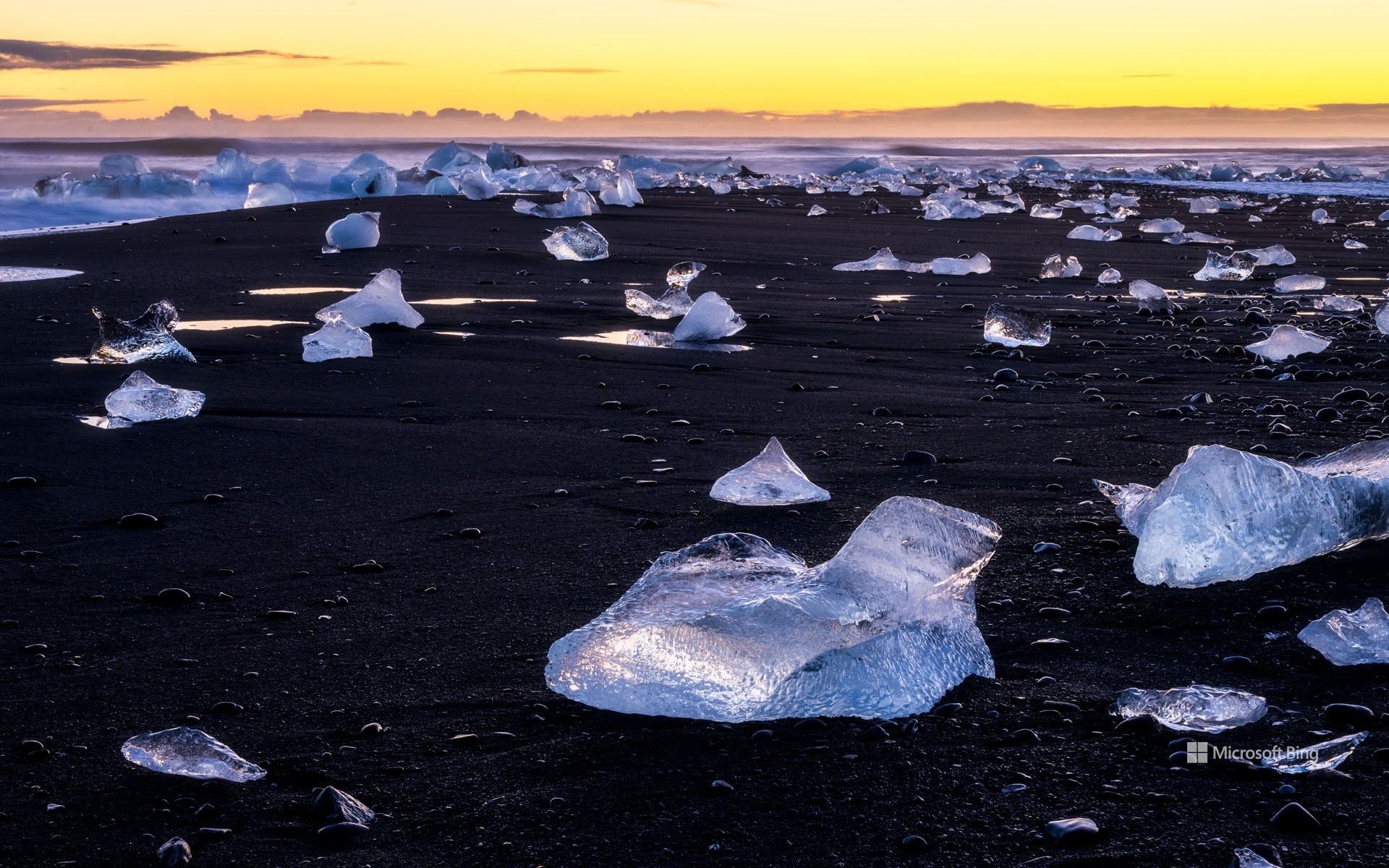
钻石冰沙滩,冰岛 Diamond Beach, Iceland (© Rachid Dahnoun/Tandem Stills + Motion)
撒了一地的“钻石” Iced out, literally
钻石冰沙滩,冰岛
从峡湾和熔岩荒原到冰洞和黑沙滩,就像我们今天在图片中看到的那样,冰岛是一个自然奇观的宝库。钻石冰沙滩是冰岛最受欢迎的自然地标之一。这个独特的沙滩位于杰古沙龙冰河湖附近,其名字源于从冰川上脱落的冰山碎片,当这些冰山碎片被冲到岸上后,在黑色沙子上就像一颗颗闪闪发光的钻石,而这些黑色沙子则是来自被侵蚀的火山岩。清澈的冰块与黑色的沙子形成鲜明对比,尤其是当阳光照射在冰面上时,会产生一种超现实的景象,因此这里是冰岛南海岸的必游之地。
Diamond Beach, Iceland
From fjords and lava fields to ice caves and black sand beaches, Iceland is a treasure trove of natural wonders. The volcanic black sand of Diamond Beach, pictured in today's image, sparkles with pieces of iceberg washed ashore from the nearby Jökulsárlón glacier lagoon. The contrast between the clear ice and black sand looks particularly surreal when sunlight hits the ice, making it a must-visit destination on Iceland's south coast.
教堂山,斯奈山半岛,冰岛 Kirkjufell, Snæfellsnes peninsula, Iceland (© Ratnakorn Piyasirisorost/Getty Images)
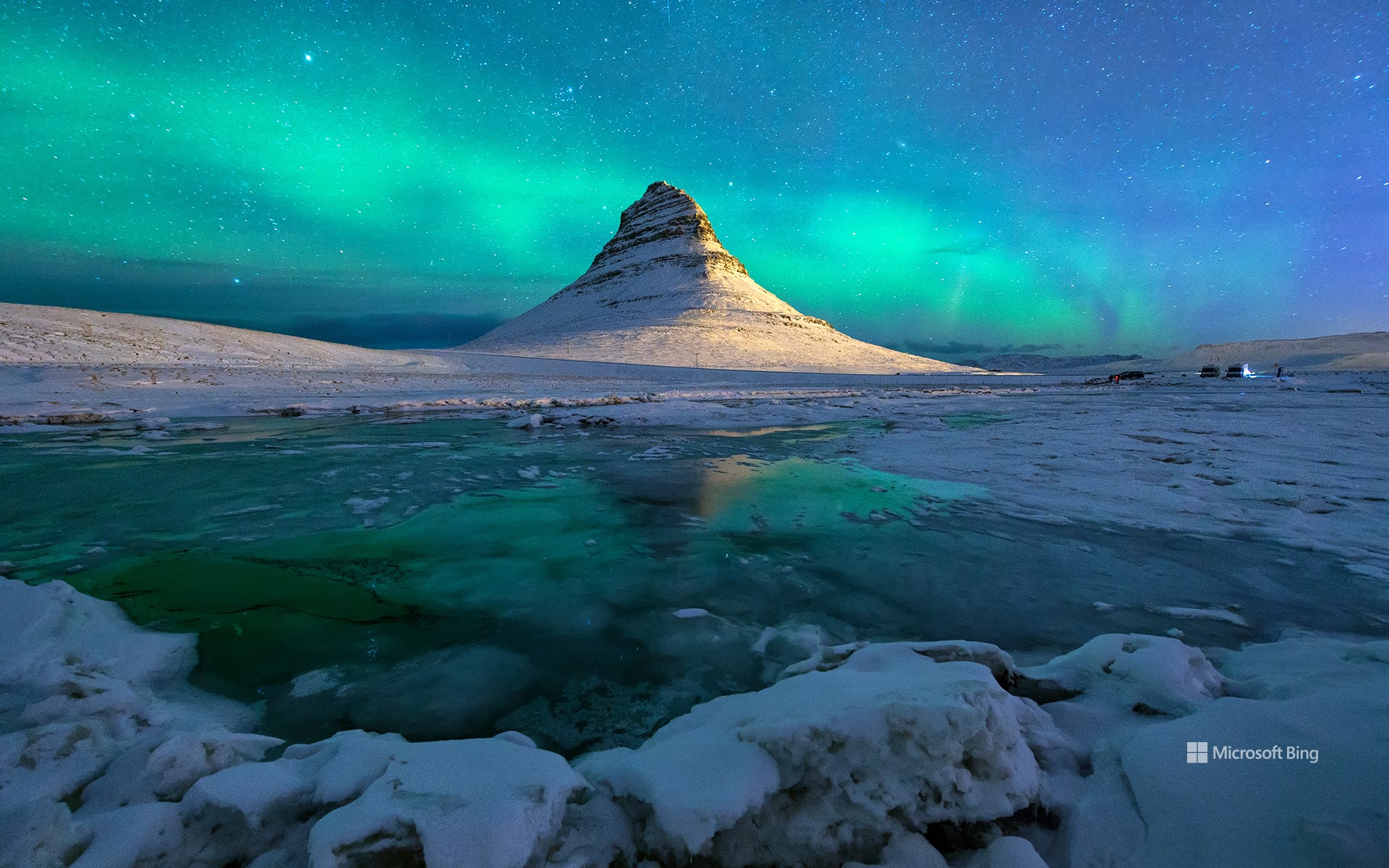
教堂山,斯奈山半岛,冰岛 Kirkjufell, Snæfellsnes peninsula, Iceland (© Ratnakorn Piyasirisorost/Getty Images)
冰与火之地 The land of ice and fire
草帽山,冰岛
从冰川和瀑布到火山和黑沙滩,冰岛的斯奈山半岛拥有“权游”中的一切。图中这座傲然屹立的小山,是海拔1519英尺高的草帽山。因其形状酷似教堂的尖塔,这座巍峨的小山又被称为教堂山。您可能在《权力的游戏》系列剧中看到过它,因为它曾出现在一幕设定在巨型冰墙以北的场景中。这个冰原岛峰(一种突出于冰原或冰川上的岩层),是摄影师们经常拍摄的对象,其金字塔般的形状、随季节变化的颜色以及沿海的地理位置,使它充满了魅力。如果运气好,天气条件允许,您还可以在草帽山看到壮丽的北极光。
Kirkjufell, Iceland
From glaciers and waterfalls to volcanoes and black sand beaches, Iceland's Snæfellsnes peninsula has 'GoT' it all. Pictured here is the 1,519-foot-high Kirkjufell, a hill often called 'Church Mountain,' as it is said to resemble a steeple. In fact, it is a nunatak, a rock formation that protrudes through an ice sheet or glacier. You might recognize it from the 'Game of Thrones' series, where it featured in a scene set north of the colossal ice wall. When it's not starring on TV, it is popular with photographers thanks to its unusual shape, coastal location, and colors that shift with the seasons. And if you're lucky, and the weather conditions align, Kirkjufell offers a magnificent view of the northern lights.
斯科加瀑布,冰岛 Skógafoss waterfall, Iceland (© Maridav/Shutterstock)
斯科加瀑布,冰岛 Skógafoss waterfall, Iceland (© Maridav/Shutterstock)
溅起一潭水花 Making a splash
斯科加瀑布,冰岛
今天照片里的是冰岛的斯科加瀑布,它是冰岛最大的瀑布之一,有82英尺宽,垂直落差约200英尺。游客经常能在这里看到彩虹,甚至是双彩虹。传说,第一个踏足冰岛的维京人曾把一个宝箱藏在了斯科加瀑布后面,这又为这个瀑布增添了一丝神秘色彩。
这个瀑布在很多热门影视作品中都出现过,比如《雷神:黑暗世界》《慷慨的心》《权力的游戏》等等。瀑布附近还有一个斯科加博物馆,可以让人们了解冰岛的文化遗产。
Skógafoss waterfall, Iceland
Behold Skógafoss, one of Iceland’s largest waterfalls. This powerful cascade measures 82 feet across and drops 200 feet over what were once the sea cliffs of the country’s southern coast. The coastline receded seaward, but the cliffs remained, leaving behind this natural wonder, powered by water from two glaciers. Skógafoss, which translates as 'forest waterfall,' is frequently graced with single or double rainbows, formed by the refraction of sunlight through the mist. Legend has it that a treasure chest is hidden behind Skógafoss, left there by a Viking settler named Prasi Porolfsson.
The waterfall has appeared on the big screen, in 'Thor: The Dark World' and the Bollywood movie 'Dilwale,' as well as on TV in the final season of 'Game of Thrones.' The Skógar Museum, which offers insights into Iceland's cultural heritage, sits near the waterfall in Skógar village.
格林达维克的蓝湖,冰岛 Blue Lagoon, Grindavík, Iceland (© Westend61/Getty Images)
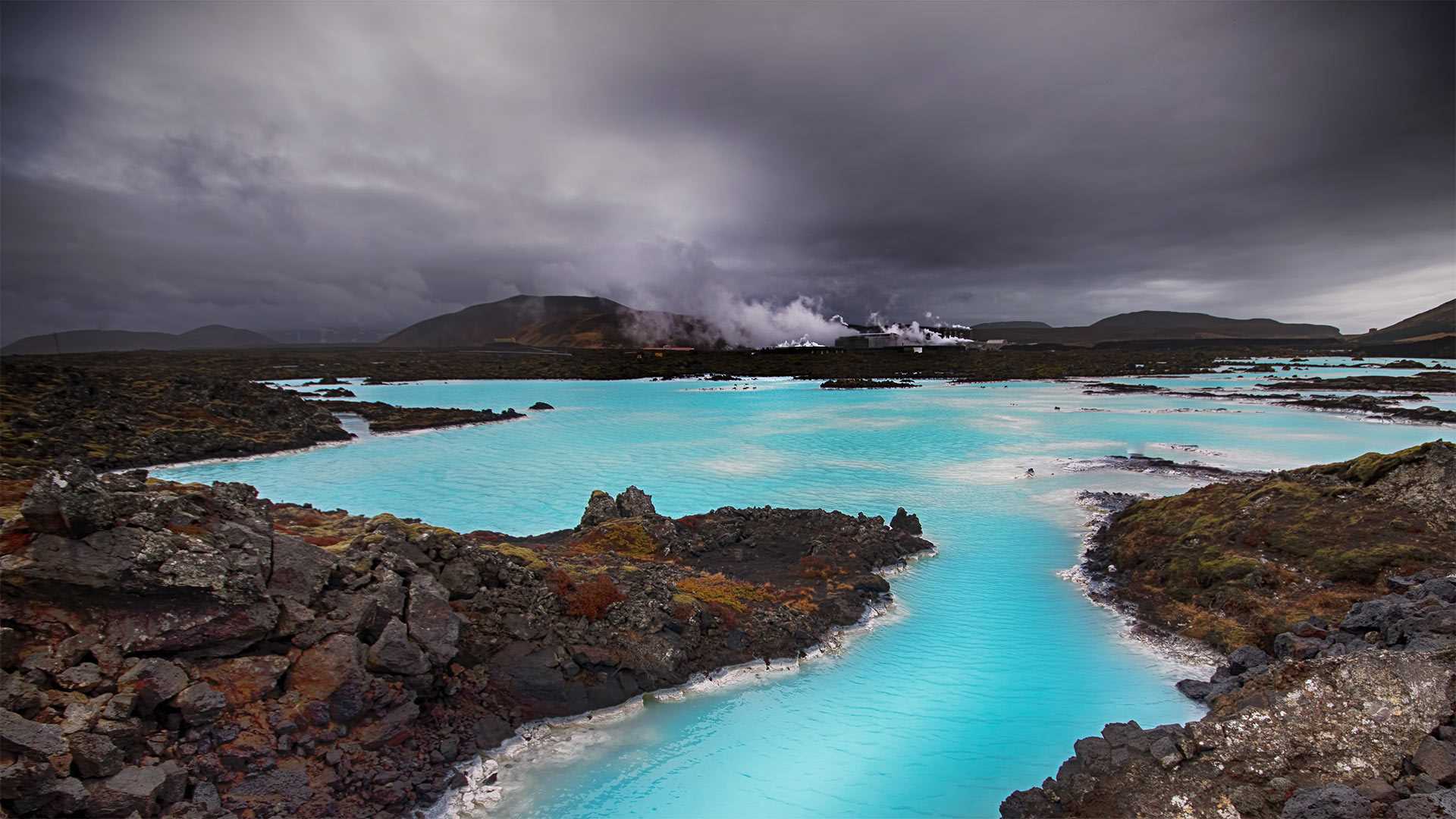
格林达维克的蓝湖,冰岛 Blue Lagoon, Grindavík, Iceland (© Westend61/Getty Images)
治愈身心的“废水” The healing powers of wastewater
蓝湖水疗,格林达维克,冰岛
坦率地说,今天这张美丽图片的来源是附近地热发电厂的废水池。虽然这听起来并不诱人,但冰岛的蓝色泻湖是该国游客最多的景点之一。诀窍是不要陷入废水的“浪费”部分。这里的水是干净的,总是在100°F左右徘徊,富含大量的二氧化硅,这正是由于工厂的工艺,使其变蓝和变硫的原因。这些矿物质和少量藻类被认为是对皮肤和整体健康非常有益的补品。
Blue Lagoon spa, Grindavík, Iceland
Let's be frank here, the origin of today's beautiful picture is a pool of wastewater from a nearby geothermal plant. While that may not sound enticing, Iceland's Blue Lagoon is one of the country's most visited attractions. The trick is to not get stuck on the 'waste' part of wastewater. The water here is clean, always hovers around 100° F, and is enriched with tons of silica—which is what makes it blue—and sulfur thanks to the plant's processes. Those minerals, along with a little algae, are believed to combine into a highly beneficial tonic for skin and overall well-being.
